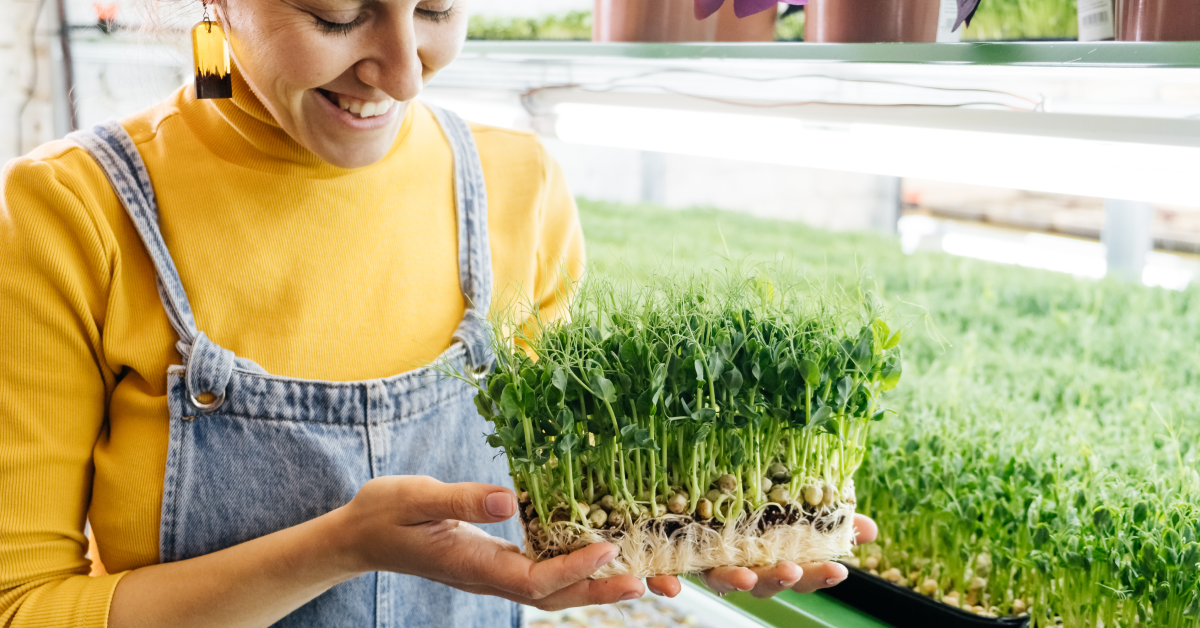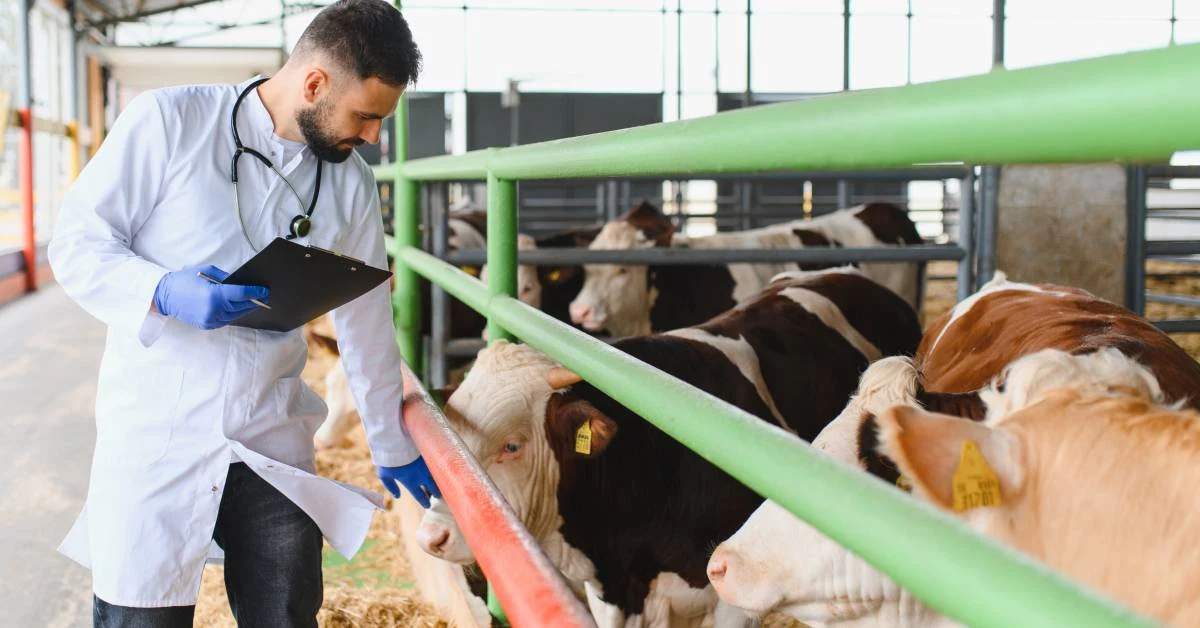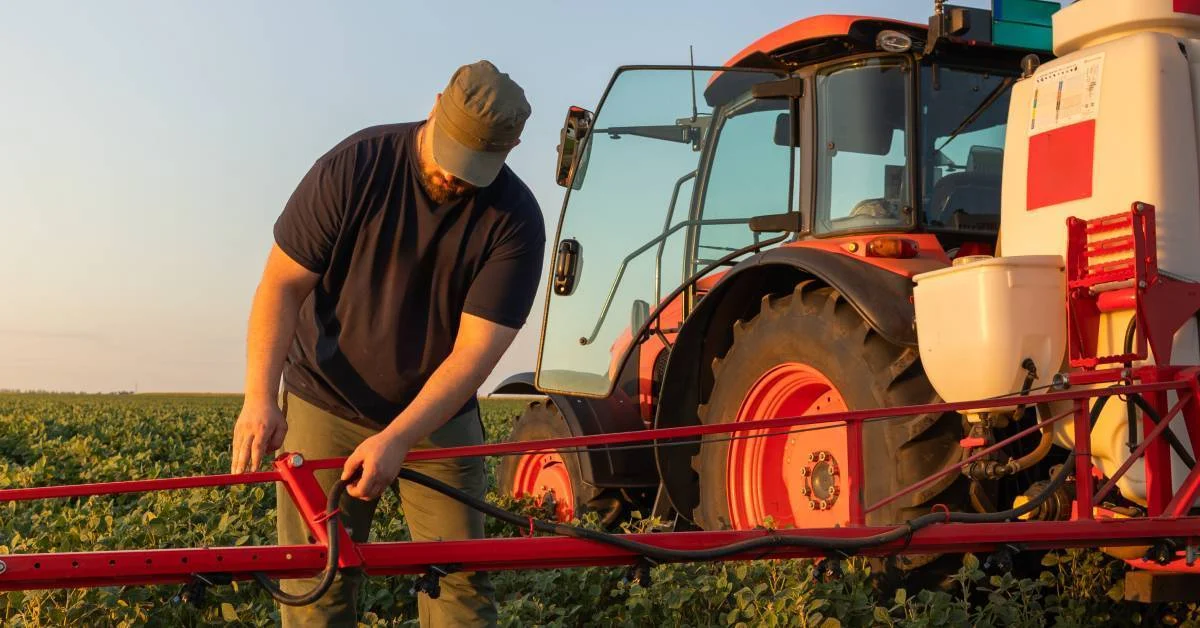Starting a microgreens business is becoming an appealing choice for many farmers and entrepreneurs looking for a profitable farming venture. With a short growth cycle and minimal investment needed, microgreens have proven to be a valuable crop for those who want to explore the potential of niche farming.
The microgreens market is seeing a surge in interest due to its promise of high returns or flexibility. The question remains for farmers new to this crop: Is growing microgreens for profit worth the effort? The answer largely depends on factors like market demand, location, and the types of microgreens being grown.
Recent statistics show that the microgreens business has been growing steadily, with a reported annual growth rate of 15%. The global microgreens market was valued at USD 1.8 billion in 2022 and is projected to grow to USD 2.6 billion by 2031, with a compound annual growth rate (CAGR) of 11% from 2022 to 2030. Many entrepreneurs have successfully sold microgreens due to their popularity in health-conscious diets, gourmet dishes, and even restaurants seeking fresh, sustainable ingredients.
But are microgreens profitable? The answer is YES if you understand the market and choose the right strategy. Some of the most profitable microgreens can fetch up to $50 per pound at retail prices. The earning potential can be significant depending on where you sell microgreens.
There are many places to sell microgreens, from local farmers’ markets to restaurants. As this guide will show, microgreen farming offers numerous opportunities for both new and experienced farmers, making it an attractive option for those curious about sustainable and profitable farming.
In this article, we’ll explore everything you need to know about growing microgreens for profit, answering questions like: Is selling microgreens profitable? And how much can you expect to earn? Whether you’re wondering how much do microgreens sell for or simply looking for tips on starting your own microgreens business, we’ve got you covered!
What Are Microgreens? – Understanding Their Value in Agriculture
Microgreens are young, edible plants harvested at an early growth stage, typically just after the first true leaves have developed. They’re packed with flavor, color, and nutrients, making them popular in restaurants and health-conscious households.
These tiny greens might be small, but they offer significant health benefits. Studies show that microgreens can contain up to 40 times more nutrients than their mature counterparts, delivering a powerful punch of vitamins, minerals, and antioxidants. This makes them highly desirable for those seeking nutrient-dense food.
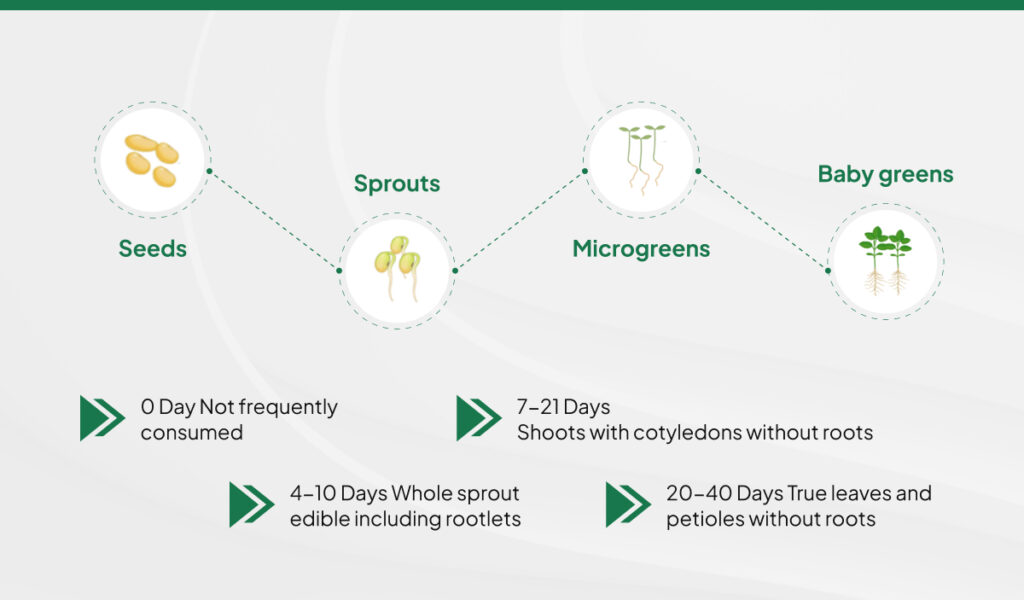
It’s essential to understand the difference between microgreens, sprouts, and baby greens:
- Microgreens are harvested when just a few inches tall, with true leaves that have started to develop.
- Sprouts are harvested earlier in their growth, often without leaves, and grow in water instead of soil.
- Baby greens are more mature than microgreens but still in their early stages. They are typically harvested when the plants are 4-6 weeks old.
Most Profitable and Popular Microgreen Varieties
In terms of the microgreens business, these tiny plants are not only a health trend but a promising opportunity for growing microgreens for profit. But which varieties are the most profitable to grow? There are several most profitable microgreens, and the right choice depends on local demand and market trends.
Some of the top microgreens in terms of popularity and profitability include:
- Arugula: Known for its peppery taste, arugula microgreens are a staple in many salads and dishes.
- Radish: Radish microgreens have a spicy kick, making them a popular choice for flavoring any meal.
- Kale: A powerhouse of nutrients, kale microgreens are valued for their health benefits and versatility.
- Broccoli: With a mild flavor and high nutritional value, broccoli microgreens are one of the most in-demand varieties.
- Sunflower: Sunflower shoots are sweet and crunchy, making them a customer favorite.
- Pea shoots: Pea microgreens are sweet and crisp, offering a mild taste that’s widely appreciated.
Market Demand – Who Buys Microgreens and Why?
The microgreens market has been expanding rapidly. According to some reports, it was valued at $1,276.0 million in 2019 and is expected to grow to $2,049.3 million by 2028, reflecting a compound annual growth rate (CAGR) of 11.1% from 2021 to 2028. This growth reflects the increasing consumer interest in fresh, nutrient-packed foods, especially among health-conscious buyers.
So, who buys microgreens, and why? The demand is growing, not just from local farmers’ markets. Restaurants are a major buyer, often seeking fresh, vibrant ingredients to garnish their dishes or add flavor and texture. Additionally, grocery stores are increasingly stocking microgreens, catering to the growing number of shoppers interested in healthy, fresh foods. Another key buyer is the health-conscious consumer, who values nutrient-dense foods for their numerous health benefits.
When thinking about where to sell microgreens, it’s important to understand your market. Some of the best places to sell include:
- Farmers’ markets, where fresh and local produce is in high demand.
- Restaurants and cafes, especially those focused on healthy or gourmet dishes.
- Grocery stores that stock organic or specialty foods.
- Direct sales to consumers through online platforms or community-supported agriculture (CSA) programs.
If you’re wondering is selling microgreens profitable?, the answer is yes. Microgreen farming is considered one of the most profitable microgreens due to their high value and short growing cycle. Some microgreens can sell for up to $50 per pound, which makes them an excellent investment for those interested in growing microgreens for profit.
Why Growing Microgreens Can Be a Profitable Business
Microgreens are becoming increasingly popular for farmers and entrepreneurs seeking a profitable agriculture business. Several factors contribute to their profitability, including quick harvest cycles, high market demand, space efficiency, and the ability to produce them year-round. Let’s explain why growing microgreens for profit can be lucrative.
Quick Harvest Cycles Allow for Faster Returns
One of the most attractive features of microgreens business is their fast growth rate. Microgreens typically mature within 7 to 21 days, making them one of the quickest crops to grow. This short growth timeline allows for multiple harvests per month, leading to a high turnover and faster returns on investment. Unlike traditional crops that take months to mature, microgreens can be harvested quickly, packaged, and sold, resulting in quick cash flow.
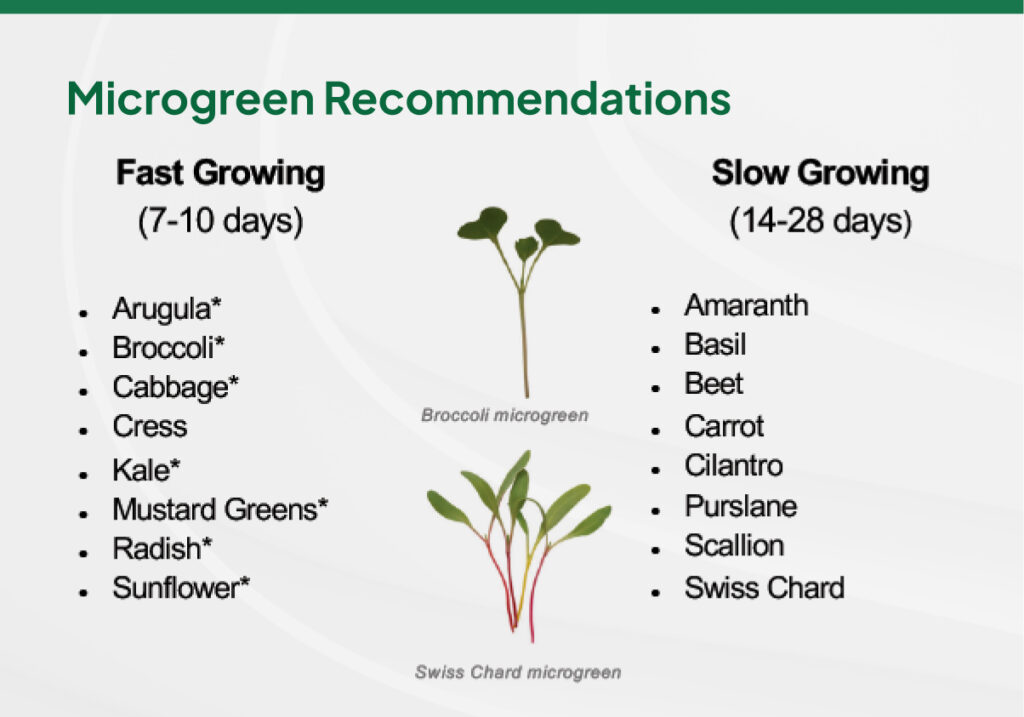
For example, radish microgreens can be harvested in as little as 7 days, while varieties like sunflower and pea shoots are ready in 10 to 14 days. With multiple harvests per month, you can grow a lot of microgreens in a relatively short period of time. This fast cycle makes microgreens farming a highly attractive option for those looking to generate income quickly.
High Market Price and Profit Margins Compared to Other Crops
Microgreens are sold at a premium price due to their high nutritional value and popularity in fine dining, health-conscious markets, and gourmet food circles. Microgreens can sell for anywhere from $20 to $50 per pound, depending on the variety. This price is significantly higher than traditional vegetables, which may only fetch a few dollars per pound at most.
The high market price and profit margins are major drivers behind the success of selling microgreens. Despite their small size, microgreens are packed with flavor, vitamins, and antioxidants, making them highly desirable. Chefs and restaurants, in particular, are willing to pay a premium for fresh microgreens to enhance their dishes.
Health-conscious consumers also pay higher prices for the nutritional benefits these greens offer. Furthermore, specialty stores and farmers’ markets often cater to customers willing to invest in fresh, local, and organic produce.
Space-Efficient Crop – Grow Microgreens Even in Small Areas
Another reason why microgreen farming is so profitable is that it is a space-efficient crop. Unlike large-scale crops that require vast amounts of land, microgreens can be grown in small spaces, making them ideal for those with limited land or urban environments. For example, people searching for a tiny house for sale Nebraska often consider how to maximize limited living and farming space. Microgreens are a perfect match because they can thrive in compact areas, even inside a small greenhouse or on vertical racks within a tiny home setup.
Because they grow vertically and do not require deep soil, microgreens can thrive in places where traditional crops would struggle. Microgreens can be grown almost anywhere, whether on a windowsill, in a small greenhouse, or using vertical farming techniques. This makes them an excellent option for city dwellers or anyone looking to maximize their space without needing large tracts of farmland.
Year-Round Production – Microgreens Farming is Not Seasonal
Microgreens are year-round, Unlike many traditional crops with specific growing seasons. Thanks to their ability to be grown indoors or in greenhouses, microgreens farming can overcome the limitations of seasonality that often affect other types of agriculture. Whether it’s the middle of winter or the height of summer, microgreens can be grown consistently throughout the year.
Indoor farming and greenhouse setups allow for controlled environments where temperature, humidity, and light can be adjusted to suit the crops’ needs. This means that microgreens can be produced regardless of the outside weather conditions, ensuring a continuous production cycle. By growing microgreens year-round, farmers can maintain a steady supply for the market and ensure consistent sales.
Microgreens’ non-seasonal nature helps farmers overcome the challenges of traditional crops, where production often slows down during off-seasons or in regions with harsh climates. Harvesting microgreens at any time of the year gives farmers a distinct advantage and provides an opportunity for continuous revenue streams.
Important Considerations Before Starting a Microgreens Business
Starting a microgreens business can be rewarding and profitable, but it requires careful planning and consideration, like any other business. Before diving into growing microgreens for profit, here are some key factors to remember:
Conducting Market Research – Understanding Local Demand
Before growing microgreens on a large scale, it is essential to conduct thorough market research. This will help you understand the demand in your local area and identify the best market opportunities for your products.
- Identify the Best Market Opportunities: Research which microgreens are in demand in your region. You can do this by speaking with local chefs, grocery stores, and health-conscious consumers who may be interested in your products. Are people in your area looking for nutrient-dense food options? Are local restaurants eager for fresh, vibrant greens to enhance their dishes? Understanding local trends will help you pinpoint which varieties of microgreens you should focus on, like arugula, radish, or sunflower.
- Researching Competitors: Take the time to analyze your competition. Are there already several local businesses selling microgreens? What are their prices, product offerings, and strengths? By studying your competitors, you can find potential gaps in the market and tailor your product offerings to meet unmet needs. This research can also help with product prioritization, ensuring you focus on offering what your target customers value most. For instance, if there’s a shortage of organic microgreens, this could be an opportunity to position your business as a supplier of fresh, locally grown organic varieties.
Creating a Business Plan for Your Microgreens Farm
A solid business plan is crucial for ensuring the success of your microgreens business. Your plan should outline your goals, target markets, and financial projections.
- Set Clear Goals: Define your short- and long-term goals. Do you want to start small and scale up, or are you aiming to launch a larger operation immediately? Establishing your goals will help you create a roadmap for success.
- Identify Your Target Markets: Decide who you’ll sell your microgreens to. Through direct sales, will you target restaurants, local grocery stores, or perhaps health-conscious consumers? Understanding your target market will help you tailor your marketing strategies and product offerings.
- Estimate Startup and Operational Costs: Calculate the initial costs of starting your business, including equipment (like growing trays and lighting systems), seeds, soil, packaging, and other essential supplies. Don’t forget to account for ongoing operational costs such as water, utilities, and labor. Understanding these costs will help you plan your finances and set pricing that ensures a profitable return. You can put all of this together using a business plan template. It helps you stay organized and update things when needed.
Understanding Legal Regulations and Food Safety Requirements
Food safety and legal regulations are critical when starting a microgreens business. Since you’ll be selling fresh produce, following local rules to ensure your products are safe for consumption is essential.
- Licenses and Permits Needed: Depending on your location, you may need specific licenses or permits to legally sell microgreens. These include a business license, a food handling permit, and a farmers’ market vendor license if you plan to sell directly to consumers at local markets. Be sure to check with your local agricultural or health department to ensure you comply with all necessary regulations.
- Best Practices for Food Handling and Sanitation: Growing microgreens involves handling fresh produce, which means food safety is essential. Follow best practices for food handling, such as maintaining proper hygiene, using clean equipment, and storing your greens in a sanitized environment. This helps prevent contamination and ensures your customers receive safe, high-quality products. Additionally, it’s a good idea to familiarize yourself with food safety regulations about product handling, including temperature requirements, packaging standards, and sanitation procedures.
Setting Up Your Microgreens Growing Operation – Equipment, Space, and Costs
Setting up your growing operation is the next step once you enter the microgreens business. Whether you’re growing microgreens for profit in your backyard or a commercial setup, choosing the right location, gathering the right equipment, and understanding the costs involved is important. Here’s a breakdown of what you’ll need to get started:
Choosing the Right Location – Indoor vs. Greenhouse Farming
When starting your microgreens business, one of the first decisions is whether to grow your plants indoors or in a greenhouse. Both options have pros and cons.
- Indoor Farming: Growing microgreens indoors can be a great option if you have limited space or live in an area with harsh climates. The main advantage is that you can control the environment year-round, regardless of outside weather. Indoor farms can be set up in small spaces like basements, garages, or even spare rooms, perfect for home-based microgreens farms. However, indoor farming may require more energy to maintain the correct temperature, humidity, and lighting.
- Greenhouse Farming: A greenhouse setup is a good choice if you can access outdoor space and utilize natural sunlight which is manageable using a greenhouse management software. Greenhouses provide an ideal environment for microgreens farming as they offer protection from harsh weather conditions while allowing you to grow crops in a naturally warmer environment. However, greenhouse setups can be more expensive to build and maintain than indoor operations, especially considering the need for ventilation, climate control, and larger growing spaces.
Essential Equipment and Supplies for Growing Microgreens
Whether growing microgreens indoors or in a greenhouse, you’ll need specific equipment and supplies to ensure a successful harvest. Here are the key items you’ll need:
- Growing Trays: Microgreens are typically grown in shallow trays with drainage holes to allow excess water to escape. Trays should be made of durable materials such as plastic or bamboo and large enough to accommodate multiple plantings.
- Growing Mediums: There are several types of growing mediums to choose from, including:
- Soil: Traditional soil is easy to use but may require additional sanitization and can lead to pests.
- Coco Coir: A popular growing medium made from coconut husks, coco coir is lightweight, sustainable, and retains moisture well.
- Hydroponics: Growing microgreens in a hydroponic system can increase efficiency and reduce the need for soil. It also requires an investment in hydroponic equipment but can result in faster growth and higher yields.
- Lighting Systems: Proper lighting is essential for growing microgreens indoors or in greenhouses. LED grow lights are the most common choice because they are energy-efficient and provide the correct light spectrum for plant growth. Depending on your setup, you may need a few small lights for a home-based farm or several large ones for a commercial operation.
- Ventilation: Good airflow is necessary to prevent mold and fungal growth. Ensure that your growing space is well-ventilated to maintain healthy microgreens. This is particularly important for indoor microgreens farming, where air circulation can be limited.
Estimated Startup Cost for a Small vs. Large-Scale Setup
The costs of starting a microgreens business can vary widely depending on the size and scope of your operation. Here’s a general idea of the startup costs:
- Small-Scale Setup: For a home-based microgreens farm, you may only need a small investment in trays, growing mediums, lighting, and ventilation. The initial costs can range from $200 to $1,000, depending on the scale and equipment quality. A small setup will typically allow you to grow a variety of microgreens for personal consumption or small-scale sales at local farmers’ markets or to friends and family.
- Large-Scale Setup: A larger, commercial-scale microgreens business will require a more substantial investment in equipment, space, and infrastructure. Depending on its size and the equipment needed for production, climate control, and storage, a greenhouse farm or indoor farming operation might cost $5,000 to $20,000 or more. This setup could allow higher-volume sales to grocery stores, restaurants, and health-conscious consumers.
Creating the Ideal Growing Environment for Healthy Microgreens
Creating the perfect environment for your microgreens is crucial to ensure they grow quickly and healthily. Here are some tips to optimize conditions for success:
- Temperature: Microgreens generally thrive in temperatures between 60°F and 75°F (15°C to 24°C). Maintaining a consistent temperature within this range is essential to promote steady growth. A temperature-controlled indoor space or greenhouse will help your microgreens grow without stress.
- Humidity: Humidity plays a key role in microgreen growth. Ideal humidity levels should be between 50% and 70%. If your space is too dry, consider adding a humidifier, especially in winter when indoor air tends to be drier.
- Light: Adequate lighting is vital for microgreens, especially in indoor farming environments. LED grow lights are an excellent choice for providing the right light spectrum while being energy-efficient. These lights should be placed around 6 to 12 inches above your trays for optimal growth. If growing outdoors or in a greenhouse, ensure that your microgreens receive at least 4 to 6 hours of direct sunlight daily.
Step-by-Step Guide to Growing Microgreens for Maximum Profit
Starting a microgreens business can be highly profitable if you follow the proper steps and best practices. From selecting the best seeds to properly harvesting and packaging profitable crops, this guide will help you maximize your yields and ensure your microgreens business thrives.
Selecting the Right Seeds for High-Yield Microgreens Farming
The key to a successful microgreens business starts with choosing the right seeds. Not all microgreens are created equal in yield and profitability, so making informed decisions is essential.
- Best Seed Varieties for Beginners and Profitable Farming: Some microgreens are easier to grow than others, especially for beginners. Popular and high-yield varieties include radish, sunflower, peas, arugula, and broccoli. These varieties proliferate, have firm flavor profiles, and are in high demand. Pea shoots and sunflower microgreens are incredibly lucrative, as chefs, grocery stores, and health-conscious consumers seek after them.
- Where to Source High-Quality Organic Seeds: Organic seeds are recommended for premium products. Quality seeds can be found at reputable agricultural suppliers or online stores dedicated to organic and non-GMO products. Websites like Seed Savers Exchange or Johnny’s Selected Seeds offer a selection of microgreen seeds trusted by commercial growers.
Sowing and Germination – Best Practices for Strong Growth
Proper sowing and germination ensure your microgreens grow quickly and efficiently. Here’s how to do it right:
- How to Plant Seeds Properly for Maximum Yield: Fill your growing trays with a suitable growing medium. Once your trays are ready, gently sprinkle the seeds over the surface. Do not overcrowd the seeds, leading to weak and stunted growth. Lightly press the seeds into the medium to ensure good seed-to-soil contact.
- Germination Conditions and Common Mistakes to Avoid: After planting the seeds, keep the trays in a dark, warm place for 2-4 days to promote germination. Ideal temperatures are between 65°F and 75°F (18°C-24°C). During this time, moisture is key, but make sure the soil isn’t too wet. Over-watering can lead to mold growth, a common issue for beginners. Covering the trays with a lid or a damp cloth can help maintain moisture and humidity levels.
Daily Care and Maintenance for Healthy Microgreens
Microgreens require consistent care to stay healthy and grow quickly. Here’s how to maintain their health throughout the growing cycle:
- Watering, Air Circulation, and Avoiding Mold Growth: Microgreens thrive when appropriately watered, but avoid soaking them. A gentle misting once or twice a day is usually sufficient. Ensure your growing area has good air circulation to prevent mold, which can quickly damage your crop. A fan can help improve airflow if needed.
- Preventing Pests and Diseases Naturally: Microgreens are generally resistant to pests, but they can still attract aphids, fungus gnats, and other small insects. To prevent infestations, ensure the growing environment is clean and avoid overwatering. If pests appear, a mild soap and water solution can help naturally remove them. For diseases, maintaining proper air circulation and avoiding overwatering will prevent most fungal issues.
Harvesting and Processing Microgreens for Market Readiness
Once your microgreens are ready for harvest, the next step is to cut, clean, and package them for sale carefully. Here’s how to prepare them for the microgreens market:
- Best Harvesting Techniques to Minimize Waste: Harvesting microgreens is delicate. Use sharp scissors or shears to cut the greens above the soil line. Avoid pulling them out of the soil, as this can damage the roots and reduce the quality of your crop. Cut in the morning when the plants are well-hydrated for the best texture and flavor.
- Proper Cleaning, Packaging, and Storage to Extend Shelf Life: After harvesting, gently rinse the microgreens to remove any soil or debris. Pat them dry with paper towels to remove excess moisture, which can lead to mold growth. Once dry, package the microgreens in ventilated containers to allow for airflow, reducing the chances of spoilage. For long-term storage, keep the microgreens in a cool and dry location. The shelf life of most microgreens is about 7 to 10 days, so it’s important to sell them quickly to ensure they’re fresh when they reach consumers.
Understanding the Financial Aspects of a Microgreens Business
Starting a microgreens business requires a clear understanding of both startup and ongoing costs and revenue potential.
Startup Costs – How Much Money is Needed to Begin?
- Initial investment includes equipment (trays, lighting, etc.), seeds, growing mediums, and setup costs for your growing space.
- Expect to pay around $500 to $2,000 for a small-scale setup. Depending on the scale and equipment required, more extensive operations can cost $5,000 to $10,000+.
Ongoing Operational Costs and Monthly Expenses
- Electricity (for lighting), water, labor, packaging, and transportation are common ongoing expenses.
- Keeping costs low involves efficient water use, energy-efficient lighting, and minimizing waste.
Revenue Potential – How Much Can You Earn Growing Microgreens?
- Income varies based on scale and market prices. On average, microgreens sell for $20 to $50 per pound, with some premium varieties fetching even higher prices.
- Successful farmers earn between $5,000 and $20,000+ monthly, depending on their scale and market demand.
Profitability Analysis – When Will You Break Even?
- Depending on the initial investment and sales volume, breaking even typically takes 3 to 6 months.
- You can achieve higher profits and grow your business over time by scaling up production or targeting higher-value markets.
Marketing and Sales Strategies to Sell Microgreens Successfully
Effective marketing and sales strategies are essential to making your microgreens business profitable. Here’s how to succeed in selling your microgreens:
Developing a Brand for Your Microgreens Business
- Branding plays a massive role in attracting customers. A strong, memorable brand can make your microgreens stand out. This includes labeling your products with clear, informative tags and incorporating a story that connects with health-conscious consumers. Enhance the visual appeal of your microgreens brand with the help of an AI logo generator that simplifies the logo creation process.
- Use logo maker to create an appealing logo and brand identity that reflects your microgreens’ freshness and health benefits.
Best Sales Channels for Selling Microgreens Profitably
- Direct-to-consumer sales: Farmers’ markets, local online stores, or a comprehensive e-commerce solution can help you reach consumers directly. Subscription boxes or community-supported agriculture (CSA) are great ways to build a loyal customer base.
- Supplying restaurants, grocery stores, and health food shops: Many restaurants seek fresh, local microgreens, and grocery stores are always looking for high-quality, healthy products to stock. Once established, this can be a stable income source.
Pricing Strategies – How to Set Competitive Yet Profitable Prices
- Pricing your microgreens depends on the market. Typically, microgreens are sold per tray, per pound, or package.
- Bulk discounts can attract larger buyers, while premium pricing for specialty varieties like broccoli or pea shoots allows you to charge higher prices for more sought-after products.
- Research your competitors to ensure you’re competitive but still make a profit.
Customer Engagement – Building a Loyal Customer Base
- Attract repeat buyers by offering exceptional service and high-quality products. Engagement through social media, email newsletters, and even sharing behind-the-scenes glimpses of your farm can help build customer relationships. Engagement through social media, where a social media post generator makes it easy to connect with your audience, along with email newsletters and behind-the-scenes glimpses of your farm, can help build strong customer relationships
- A well-planned social media marketing strategy can further strengthen these connections and keep your audience engaged.
- Offer incentives like loyalty programs, discounts for bulk purchases, or free samples to keep customers returning for more.
Challenges and Risk Management in the Microgreens Business
Starting and maintaining a microgreens business presents unique challenges. Understanding these hurdles and managing them is key to long-term success.
Common Challenges Microgreens Farmers Face
- Mold and Pests: Microgreens are highly susceptible to mold and pests due to their moist growing environment. These issues can damage crops and reduce yields.
- Growing Conditions: Microgreens require specific conditions, including controlled temperature, humidity, and light. Inconsistent conditions can lead to poor growth and crop failure.
- Market Fluctuations and Price Competition: The microgreens market can be volatile, with fluctuating prices and competition from large producers and small local farms. When prices drop, this can significantly impact profitability.
How to Overcome Common Problems and Reduce Risks?
- Preventative Measures for Mold and Pests: To reduce the likelihood of mold, ensure proper air circulation and moisture control. Use organic pest control methods or natural predators to combat pests without harmful chemicals.
- Diversify Sales Channels: To reduce reliance on a single revenue stream, sell microgreens through multiple channels such as farmers’ markets, restaurants, and grocery stores. Expanding your reach to different markets can help buffer against market fluctuations.
Conclusion – Is Growing Microgreens a Good Business for You?
While the microgreens business has its challenges, it remains profitable and rewarding with proper planning and risk management. If you’re ready to address growing conditions, market fluctuations, and other challenges, growing microgreens for profit can be a wise investment, especially for those interested in health-conscious and sustainable food solutions.
FAQs
Are Microgreens A Profitable Business?
Microgreens can be highly profitable due to their fast growth cycle, high market demand, and low production overhead costs.
Which Microgreen Is Most Profitable?
Popular and profitable microgreens include sunflower, pea shoots, radish, and basil, with demand varying based on location and market preferences.
Do Microgreens Grow Back After Cutting?
No, microgreens do not grow back after cutting. They are typically harvested once, and new crops must be planted for each harvest.
Are Microgreens Still Profitable In 2024?
Microgreens continue to be profitable in 2024, driven by the increasing interest in healthy eating and sustainable farming practices.
How Much Does One Tray Of Microgreens Produce?
Depending on the variety and growing conditions, one tray of microgreens can yield 4-6 ounces of fresh greens.
Are Microgreens Expensive?
Microgreens can be considered expensive compared to regular vegetables, but their high nutrient content and fast-growing cycle justify the price for consumers.
What Are The Best Containers For Selling Microgreens?
The best containers for selling microgreens are lightweight, breathable clamshell boxes or plastic trays that allow for air circulation and keep the greens fresh.
How Fast Do Microgreens Grow?
Microgreens typically multiply, with most varieties reaching harvestable size in 7 to 21 days, depending on the type.

